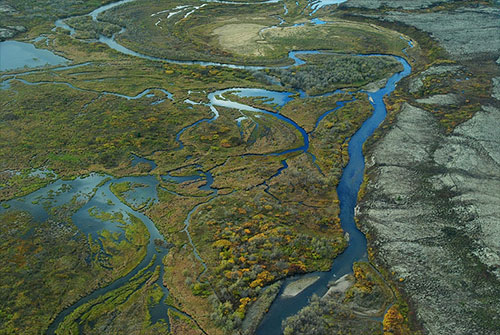
EPA Proposes to Withdraw Clean Water Act Restrictions for Pebble Mine
July 11, 2017
EPA is consulting on the proposed withdrawal with federally-recognized tribal governments of the Bristol Bay region and with Alaska Native Claims Settlement Act Regional and Village Corporations with lands in the Bristol Bay watershed. The public comment and tribal consultation process allows EPA to hear from the public before final decisions are made. After the close of the public comment and tribal consultation process, the EPA will decide whether to issue a final withdrawal of the 2014 Proposed Determination. EPA is also requesting public comment on whether the EPA Administrator should review and reconsider a final withdrawal decision, if such a decision is made.
On May 11, 2017, EPA entered into a settlement agreement with the Pebble Limited Partnership to resolve litigation from 2014 relating to EPA's prior work in the Bristol Bay watershed in Alaska. The settlement provided the Pebble Limited Partnership (Pebble) an opportunity to apply for a Clean Water Act (CWA) permit from the U.S. Army Corps of Engineers before EPA may move forward with its Clean Water Act process to specify limits on the disposal of certain material in connection with the potential “Pebble Mine.” In July 2014, EPA Region 10 initiated a process to protect one of the world’s most valuable salmon fisheries, in Bristol Bay, Alaska, from the risks posed by a mine at the Pebble deposit. After completing a multi-year effort to assess the Bristol Bay watershed, and the EPA issued a Clean Water Act Section 404(c) Proposed Determination to restrict discharges of dredge or fill material into the watershed from mining the Pebble deposit. Section 404 is the part of the Clean Water Act that governs the permit evaluation process for actions that discharge dredged or fill material into waters of the United States. EPA agreed to initiate a process to propose to withdraw the Proposed Determination as part of a May 11, 2017 settlement agreement with the Pebble Limited Partnership, whose subsidiaries own the mineral claims to the Pebble deposit. The agreement provides Pebble additional time to apply for a Clean Water Act 404 permit from the U.S. Army Corps of Engineers before EPA moves any further with its Clean Water Act Section 404(c) review. The Bristol Bay watershed in southwestern Alaska supports the largest sockeye salmon fishery in the world, is home to 25 federally recognized tribal governments, and contains large mineral resources. The Nushagak River and Kvichak River watersheds are the largest of Bristol Bay's six major river basins and compose about 50% of the total watershed area. The Bristol Bay watershed provides habitat for numerous animal species, including 29 fishes, more than 190 birds, and more than 40 terrestrial mammals. Chief among these resources is a world-class commercial and sport fishery for Pacific salmon and other important resident fishes. The watershed supports production of all five species of Pacific salmon found in North America: sockeye, coho, Chinook, chum, and pink. Because no hatchery fish are raised or released in the watershed, Bristol Bay's salmon populations are entirely wild. These fish are anadromous - hatching and rearing in freshwater systems, migrating to the sea to grow to adult size, and returning to freshwater systems to spawn and die. The most abundant salmon species in the watershed is sockeye salmon. The Bristol Bay watershed supports the largest sockeye salmon fishery in the world, with approximately 46% of the average global abundance of wild sockeye salmon. Between 1990 and 2010, the annual average inshore run of sockeye salmon in Bristol Bay was approximately 37.5 million fish. Annual commercial harvest of sockeye over this same period averaged 27.5 million. Approximately half of the Bristol Bay sockeye salmon production is from the Nushagak River and Kvichak River watersheds. Public Comment Information Public comments on EPA’s proposals must be received on or before 90 days from the date of publication of the Federal Register Notice. Comments may be emailed to: ow-docket@epa.gov with docket number EPA-R10-OW-2017-0369 in the email subject line.
On the Web:
Editing by Mary Kauffman, SitNews
Source of News:
Representations of fact and opinions in comments posted are solely those of the individual posters and do not represent the opinions of Sitnews.
|
|||
